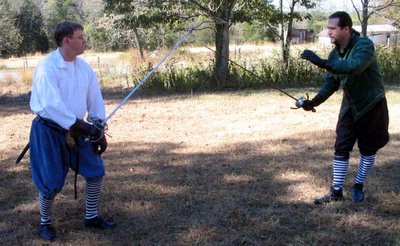Another of his methods of trying to control his opponent's behavior is to reverse his stance. Many people use this stance because they intend to use a hand parry to get control of the opposing blade before or during their attack. Swetnam's primary objective, however, is to offer the left shoulder as bait.
 When your opponent thrusts at your apparently open left shoulder, you step back with your left foot to pull your shoulder back out of range. At the same time you thrust into your opponent's sword arm, which he has conveniently put out into range for you. As usual, I tend to add a hand parry for good measure and to keep my opponent's blade under control as much as possible.
When your opponent thrusts at your apparently open left shoulder, you step back with your left foot to pull your shoulder back out of range. At the same time you thrust into your opponent's sword arm, which he has conveniently put out into range for you. As usual, I tend to add a hand parry for good measure and to keep my opponent's blade under control as much as possible. On the remote chance you haven't figured this out already, all of my instructions assume that you're a right-handed fighter; you should reverse all of the left-right directions I've been giving if you're holding the sword in your left hand. In this, I'm just following Swetnam's convention, as well as giving instructions the way the majority of fencers will use them.
On the remote chance you haven't figured this out already, all of my instructions assume that you're a right-handed fighter; you should reverse all of the left-right directions I've been giving if you're holding the sword in your left hand. In this, I'm just following Swetnam's convention, as well as giving instructions the way the majority of fencers will use them.Part 4

1 comment:
This little gem plays to my strengths. Thank you for sharing.
Post a Comment